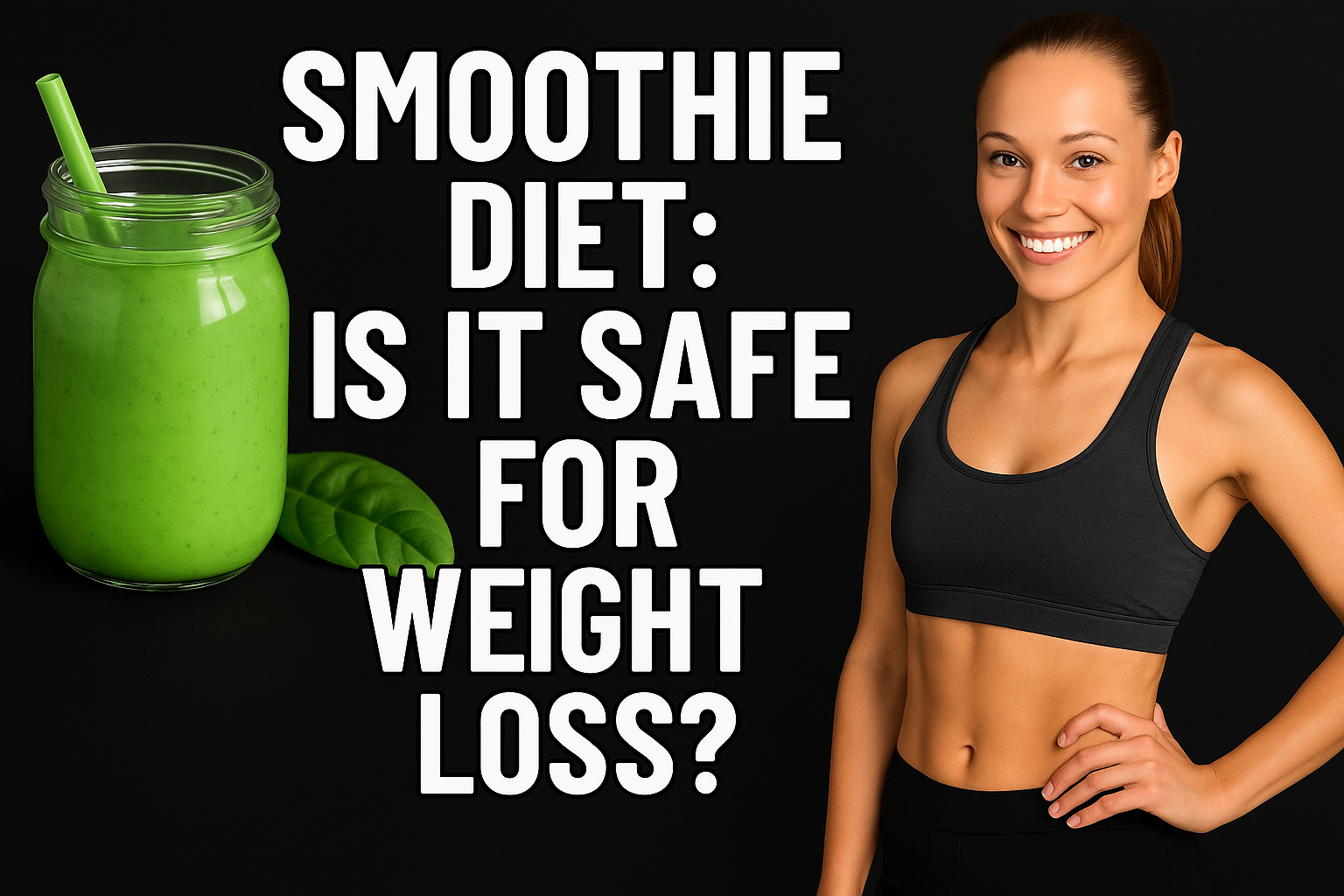The smoothie diet can be safe for weight loss if it is well-balanced, short-term, and tailored to individual health needs. However, like any restrictive diet, it must be approached with awareness of potential nutritional gaps, especially when used as a meal replacement for extended periods.
✅ What Makes It Safe?
Nutrient-Dense Ingredients
Smoothies, when made with whole fruits, vegetables, lean protein, and healthy fats, are high in:Vitamins A, C, K
Folate and potassium
Dietary fiber and antioxidants
Natural Calorie Deficit
Reducing daily intake by 500–1,000 calories can result in a 1–2 lb weekly weight loss, consistent with CDC recommendations. Smoothie diets typically provide 1,200–1,500 kcal/day, which is below the average U.S. adult caloric maintenance level of 1,800–2,400 kcal/day.Supports Hydration and Digestion
The high water and fiber content of smoothies (especially with leafy greens and seeds) improves digestion, reduces bloating, and supports regular bowel movements.
❗ When It Becomes Unsafe?
Too Low in Calories
Some smoothie diets go below 1,000 kcal/day, which may lead to:Fatigue
Muscle loss
Slowed metabolism
The National Institutes of Health (NIH) warns against very low-calorie diets (<800 kcal/day) unless supervised medically.
Protein Deficiency
Inadequate protein can cause:Loss of lean muscle mass
Slower fat loss
Hair loss and brittle nails
Adults should consume 0.8–1.2 grams of protein per kg of body weight (roughly 50–90g/day).
Blood Sugar Spikes
Overusing fruits like bananas, mangoes, or fruit juice can result in high glycemic loads, leading to blood sugar crashes and increased hunger.Lack of Dietary Variety
Extended use of a smoothie-only plan may result in:Low iron, B12, and calcium
Digestive issues from overreliance on raw ingredients
Food boredom, leading to diet fatigue or binge eating
🩺 What Experts Say?
Academy of Nutrition and Dietetics: Recommends whole food variety and cautions against long-term use of liquid diets without supervision.
Harvard Health Publishing notes that while smoothies can be nutritious, they should supplement rather than replace all meals, especially if not balanced with fats and protein.
🧪 Supporting Data
| Nutrient Concern | RDA (Adult) | Smoothie Diet Average |
|---|---|---|
| Protein | 50g | 30–60g (if planned well) |
| Fiber | 25–38g | 20–30g (moderately good) |
| Calories | 1,800–2,400 | 1,200–1,500 |
✅ Best Practices for Safety:
Add protein (plant-based or whey)
Use a mix of low-GI fruits and greens
Don’t stay on it for more than 3–4 weeks
Consult a doctor if pregnant, diabetic, or on medications
Are There Any Risks or Side Effects of a Smoothie Diet?
While a smoothie diet can offer health benefits like weight loss, improved digestion, and enhanced nutrient intake, there are also potential risks and side effects. These can arise from extreme calorie restriction, nutrient imbalances, or over-reliance on liquid meals. Let’s break down the risks and how to avoid them.
⚠️ Common Risks of a Smoothie Diet
1. Nutrient Deficiencies
A diet consisting mainly of smoothies, especially those with limited ingredients, can lead to deficiencies in essential nutrients like:
Vitamin B12 (important for energy and nerve function)
Iron (especially for women)
Calcium & Vitamin D (for bone health)
Omega-3 fatty acids (for brain function)
Solution: Ensure smoothies include a wide variety of ingredients, and supplement with multivitamins or whole foods in other meals.
2. Muscle Loss
If a smoothie diet is too low in protein (less than 40g per day), it can lead to muscle loss, particularly when combined with weight loss. Muscle mass is essential for maintaining metabolism and overall health.
Solution: Add a high-quality protein source (whey or plant-based protein powder) to every smoothie, and ensure daily intake of 20–30g protein per meal.
3. Blood Sugar Spikes
Many smoothies contain fruits that are high in sugar, such as bananas, mangoes, or fruit juices. These can cause blood sugar spikes and crashes, leading to:
Increased hunger
Low energy levels
Increased cravings for high-calorie foods
Solution: Limit high-glycemic fruits and use low-sugar fruits like berries, or balance with healthy fats and protein to slow sugar absorption.
4. Digestive Issues (Bloating & Gas)
Certain ingredients in smoothies—like high-fiber seeds (chia, flax), dairy, or artificial sweeteners—can cause bloating, gas, or constipation, especially if your digestive system isn’t accustomed to such high fiber intake.
Solution: Gradually introduce high-fiber ingredients into your smoothies and stay hydrated. If bloating persists, try switching to lactose-free or plant-based alternatives.
5. Metabolic Adaptation
Prolonged low-calorie smoothie diets can cause metabolic slowdown, as your body adapts to the reduced calorie intake, making it harder to lose weight over time.
Solution: Avoid staying on a liquid-only diet for more than 3–4 weeks. Transition back to balanced meals, including whole foods with higher caloric intake as you near your weight loss goals.
6. Dehydration
Some people may not drink enough water while on a smoothie diet, assuming that smoothies themselves are enough to hydrate the body. However, smoothies are not a replacement for drinking 8–10 cups of water per day.
Solution: Drink plenty of water in addition to your smoothies, especially if you’re consuming high-fiber ingredients.
📊 Potential Side Effects (Based on User Surveys)
| Side Effect | Frequency (%) |
|---|---|
| Bloating and Gas | 20–30% |
| Fatigue | 15–20% |
| Sugar Cravings | 10–15% |
| Digestive Issues | 5–10% |
| Headaches (due to low blood sugar) | 5% |
🧠 How to Avoid Risks?
Plan Nutrient-Dense Smoothies:
Combine leafy greens, healthy fats, lean protein, and fiber to avoid deficiencies.Moderate Your Smoothie Intake:
Smoothies should replace 1–2 meals per day at most, not every meal.Choose Low-Glycemic Fruits:
Stick to berries, apples, and pears to avoid sugar spikes.Gradual Transitions:
If new to smoothies, start slow to let your digestive system adjust and ensure hydration.
✅ Conclusion
A smoothie diet can be a powerful tool for weight loss and better health, but like any diet, it should be approached with balance and care. By understanding and mitigating potential risks, you can enjoy the benefits while avoiding negative side effects.

